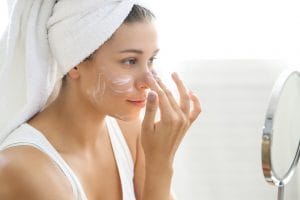 Photo: Getty
Photo: Getty A GROWING parade of patients with red, rashy or scaly skin started showing up at Dr. Sandy Skotnicki’s clinic in downtown Toronto. As a dermatologist with an academic interest in allergic contact dermatitis, she was suddenly deluged with appointment requests.
Equally of concern was that the new patients seemed completely unaware why this skin trouble was occurring. Their first questions were frequently: “Is it dairy? Is it gluten?” What did they need to stop eating to fix this unsightly, embarrassing and painful rash?
“Everyone wants to blame food. But in adults, when we’re talking about rashes, like chronic itchy dermatitis, that’s not from food,” Skotnicki says, noting that the skin would show hives, not rash, in food allergy. “When I tell people, ‘it’s the soap you’re using, it’s the fragranced shampoo with 30 ingredients, it’s because you’re washing twice a day, they look at me like I’ve got two heads.”
The consumer has been missing the point: It’s not what we put into our bodies, it’s about what we put onto the skin.
Aware that as many as 40 percent of North Americans believe they have sensitive skin and need help to manage it, Skotnicki published a book called Beyond Soap. Her message is that, across North America, dermatologists are seeing an epidemic of damaged skin. The condition is self-inflicted but also, asserts Skotnicki, one that can be turned around.
“There is a societal disconnect,” she says. “People don’t think about over-washing and that their cream, even one labeled “hypoallergenic,” could actually be causing a problem.”
A growing number of people have allergic contact dermatitis (or eczema) to beauty product ingredients, but the more widespread problem that Skotnicki sees is non-allergic, irritated skin, known by the catchall of sensitive skin.
The book explains that our soap and detergent-filled cleansing routines are stripping away the skin’s important fat molecules and good bacteria. We then employ a plethora of products, loaded with irritating ingredients, such as fragrance and preservatives. Applied to skin cleansed into submission, it’s like a recipe for rash.
Dermatologist’s Wakeup Call
So how did we get here? “It’s marketing,” says Skotnicki says. She points at the behemoth beauty industry – today worth an astounding $400 billion worldwide – which has nurtured skincare routines until many women, and a growing number of men, have arrived at a state of beauty product obsession.
We’ve fallen hard for the industry’s pitch. The fragranced lotions, the toners, the creams, face serums and anti-aging elixirs are all made to sound so essential, so appealing. Who stopped to think they might ravage our sensitive skin?
Skotnicki is who. Beyond Soap serves as a wakeup call to the misled consumers and government regulators, and demands the beauty industry take accountability. She wants nothing short of a revolution in how we care for our skin. To stop the needless damage, we need to wash less and rethink all the beauty products. The mantra for the sensitive skin revolution she’s trying to start could be “less, less, and less again.”
I sat down with Skotnicki to learn more. In our conversation, she covered many key themes from her book, such as what to use, what to avoid and “hypoallergenic” labeling.
What’s wrong with the way North Americans wash?
Skotnicki says that it’s only in the past 70 years that we got so clean, and that evolved with the rise of the soap industry. “Your great-grandmother washed once a week and she was fine.”
The dermatologist explains that the healthy, natural state of the skin is slightly acidic, but soap, and even water, can be quite alkaline. She draws the comparison to a brick wall, with the skin as the wall, and the fat molecules known as lipids as the mortar.
“Even just the act of washing with hot water removes your mortar,” she says. “Then you add in soap which grabs onto the dirt and the oil and it takes it off the skin.” The result? A compromised skin barrier, which means “you’re setting yourself up for irritation or itchiness or even allergy.”
So how often to shower? While we’re all different, her general answer is: “Don’t shower if you’re not dirty. When you do shower, make it not too hot, not too long.” If foregoing the shower, her advice is to “just wash ‘your bits,’ the underarms, the groin and the feet.” She knows the idea of not showering daily is radical, but it just happens to be good for the skin.
What are the main problems with sensitive skin and beauty products?
 Dr. Sandy Skotnicki sees a societal disconnect between the epidemic of skin problems and beauty product regimens. Photo: Steve Dolson
Dr. Sandy Skotnicki sees a societal disconnect between the epidemic of skin problems and beauty product regimens. Photo: Steve Dolson A cleanser may have 40 ingredients, a moisturizer and eye makeup another 30. Shampoos are very problematic. “They usually have north of 30 ingredients,” some hidden within generic terms like “fragrance”. Since a reaction to a shampoo tends to start on the face or neck, the connection can be missed.
Shampoos are one of the products that have water in them, so a preservative will be added to stop bacteria growth. Among the biggest offenders is methylisothiazolinone, known as MI, which under European regulations is now only allowed in minuscule amounts in rinse-off products. In the United States, there is no such rule, while in Canada MI is allowed in rinse-off products. Another top culprit is linalool.
As these are allergens, Skotnicki can patch test against such preservatives. “Shampoo reactions are an epidemic,” she says. “I see one a day.”
Are botanicals and essential oils safer?
Fragrance tops dermatologists’ lists of triggers for sensitive skin outbreaks, and they can patch test using mixes of specific fragrance molecules. Some patients with sensitive skin or contact dermatitis to fragrance ask Skotnicki if it’s safe to use natural, organic perfumes instead.
She asks them to think about this fact: rose is a fragrance, so are lemon and lavender. “There’s a disconnect for people with reactivity,” she says. “They might know the synthetic gives them a rash, so they try the organic. But the truth is they’re still fragrance, they’re still irritating.”
“An essential oil is made of say, 20 ingredients. You’re drawing out all of these chemicals from a plant, it’s not one thing.” That highly allergenic preservative called linalool? It’s in lavender oil, and many people get rashes from it.
How does cumulative “chemical load” relate to skin problems?
Skotnicki sees patients with some severe product-based problems. She writes of a lawyer who arrived with reptilian-looking scales on her cheeks, eyelids, forehead and neck. In her view, sometimes the symptoms relate to chemical overload.
The cumulative idea “can be a hard concept to grasp,” she says. “It’s not your face wash. It’s your face wash plus your moisturizer plus your eye shadow and then you add shampoo that you rinses over your face, and your skin has simply had enough.”
Skotnicki first noticed this with nurses who had hand dermatitis from continuous hand-washing. “Irritation accumulates. There’s this threshold after which your skin will just break down.”
How do you “fix” all the broken skin?
When the skin has been damaged through over-washing and over-use of products, the dermatologist says it’s important first to stop that exposure. You may relate the term “elimination diet” to food allergies, but Skotnicki has developed a sensitive skin version, a structured avoidance regimen that’s laid out in the book. The short version is that it starts with cutting out all the products you’re currently using. This includes makeup for at least two weeks. She calls it “hitting the reset button.”
The products you do use are only those from her “Low-Contact Allergen and Irritant List,” with specific products from brands such as Avene, CeraVe, Aveeno and more. The seven-page list offers fragrance- and irritant-free shampoos, cleansers, moisturizers, sunscreens, even laundry detergents.
In Skotnicki’s practice, she’s often gets patients on the elimination diet until she’s got a window for patch testing (a series of three visits). “So they go home. They use perhaps the CeraVe soap and one of the shampoos on that list, and call to say: ‘I can’t believe it; I’m all better.’ It works.”
Once the skin reaction has gone, she tells patients to reintroduce one product, a week at a time. Any that irritate are then taken off the expanded list.
Are allergens and irritants regulated and labeled?
Allergic Living has written before that North American oversight of cosmetics ingredients is woefully inadequate. In the U.S., the FDA still relies on its old Food, Drug and Cosmetic Act, which doesn’t require full ingredient or allergen labeling. Two senators put forward a proposed Personal Care Products Safety Act in 2017, but it never got anywhere.
Plus, there is no regulation of the use of terms, such as “hypoallergenic” or “unscented”. Products with either sometimes still contain fragrance. Skotnicki finds the term “fragrance-free” somewhat more reliable, but even then, it’s not regulated and it’s wise to check with the company if you know your skin triggers.
The better news is that Europe has been far more proactive, with dermatologists leading the charge to regulation after allergic outbreaks to preservatives like MI and some fragrances. The EU has now banned three fragrances from products, another 23 allergens must be overtly labeled, and more fragrances are under review.
In North America, we reap the benefits of the EU’s oversight, since multinationals such as L’Oréal and Unilever use the European regulations to guide their product labeling. But beauty products that are only sold in North America don’t need such compliance, and a catchall term like “parfum” may cover a host of potential allergens.
So “buyer beware” remains the situation. “At the very least skin-care companies should be required to state fragrance components that are allergenic, the way the EU does,” notes Skotnicki.
Find out more about Dr. Skotnicki’s book, Beyond Soap, here.
Had a serious reaction to a cosmetic product? Make the FDA aware, by filing a report here.
Related Reading:
Safe Makeup Tips for Eczema (Atopic Dermatitis)
Body Piercings and Rash: How Do You Know If It’s a Nickel Allergy?
Can Aloe Vera Make Your Skin Break Out in a Rash?





